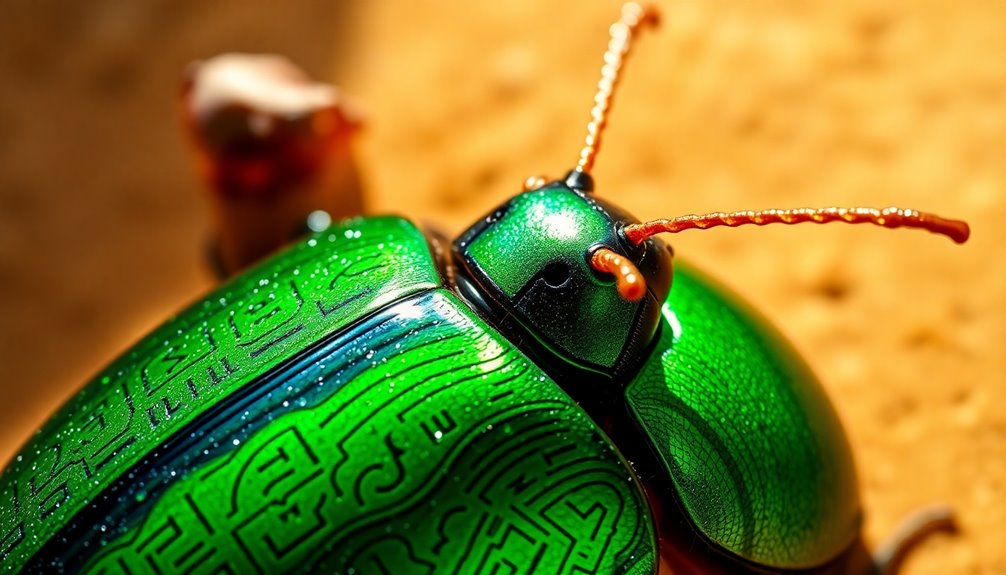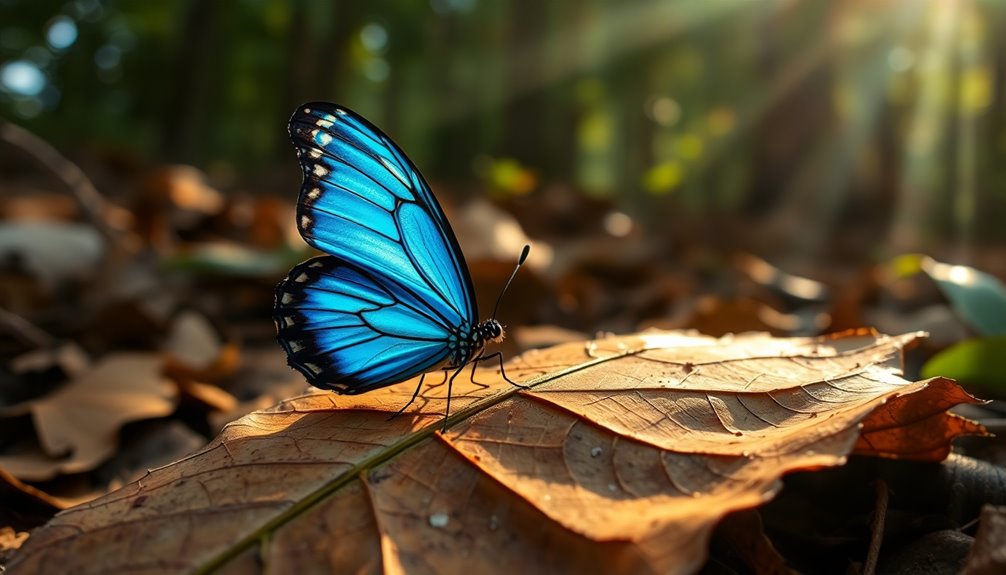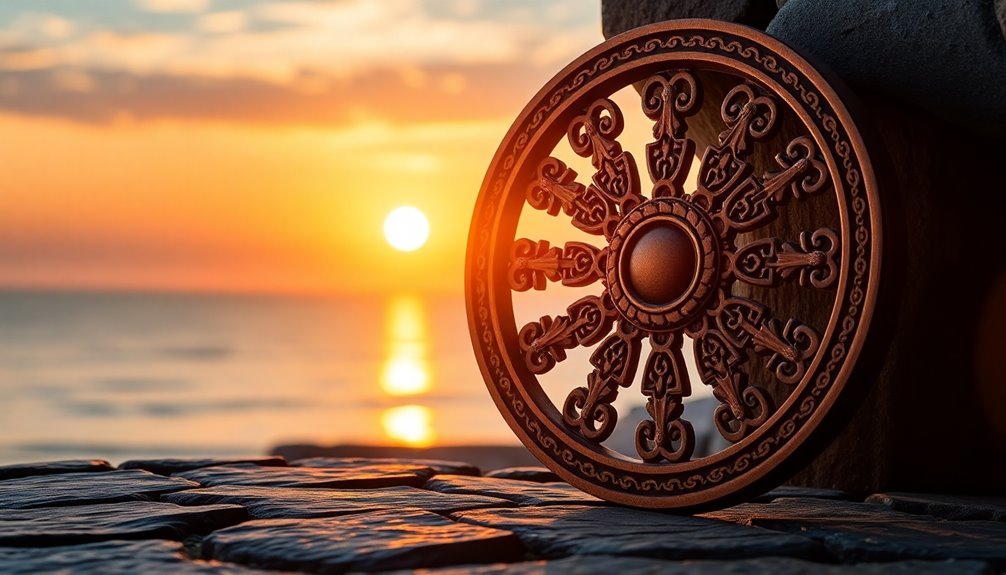The scarab beetle might just surprise you as a powerful symbol of death and rebirth. In ancient Egypt, it represented the sun god Khepri and reflected beliefs in immortality and regeneration. Scarabs were often placed in tombs as protective amulets, aiding in the soul's journey to the afterlife. Their life cycle, transforming from larva to adult, echoes themes of renewal. This iconic beetle continues to influence modern culture, appearing in jewelry and art. Curious about how the scarab persists in today's symbolism and culture? There's a lot more to discover about this remarkable creature.
Key Takeaways
- The scarab beetle, particularly Scarabaeus sacer, is a prominent symbol of death and rebirth in ancient Egyptian mythology.
- Associated with the sun god Khepri, scarabs represent regeneration and the life-death cycle.
- In burial practices, scarab amulets were used to ensure safe passage and resurrection in the afterlife.
- Scarabs, especially dung beetles, play a vital ecological role by recycling nutrients and enriching soil health.
- Today, scarabs continue to inspire modern art and jewelry, symbolizing transformation and the cycles of life.
The Scarab and Its Significance

The scarab beetle, especially Scarabaeus sacer, stands as a powerful emblem of death and rebirth in Ancient Egypt. Revered for its association with the sun god Khepri, the scarab symbolizes the cyclical nature of life.
You'll find Egyptian scarabs depicted in art and jewelry, serving not just as decorative pieces but also as protective amulets. These amulets were believed to guard against evil spirits and aid in the journey to the afterlife.
The behavior of dung beetles, which roll dung balls, inspired these beliefs about eternal movement and resurrection. Egyptians observed that these beetles seemed to create life from waste, mirroring the transformation of death into new beginnings.
Scarab amulets emerged during the Old Kingdom and gained inscriptions and religious significance by the New Kingdom, emphasizing the heart's role in the afterlife.
Today, modern interpretations of scarabs continue to embody themes of rebirth and regeneration. Their imagery remains popular in jewelry and tattoos, reflecting their lasting cultural importance.
Ancient Egyptian Beliefs

In Ancient Egypt, the scarab beetle wasn't just an insect; it was a powerful symbol woven into their mythology and beliefs.
You'd find scarabs in burial practices, where they played a crucial role in ensuring safe passage to the afterlife.
Understanding this symbolism helps you appreciate how deeply the Egyptians valued transformation and immortality.
Scarab Symbolism in Mythology
During ancient times, the scarab beetle became an essential symbol in Egyptian mythology, representing rebirth and regeneration. The ancient Egyptians revered the scarab, particularly Scarabaeus sacer, associating it with the sun god Ra and the cycle of life and death. They believed that just as the scarab rolls dung into balls to nourish its larvae, life emerges from decay, symbolizing the eternal cycle of life.
Scarabs were often depicted in art and crafted into jewelry, serving as protective amulets. They were thought to bring good luck and ward off evil spirits, ensuring safe passage to the afterlife. The beetle's behavior was also metaphorically linked to the sun's journey across the sky, reinforcing the idea of eternal movement and rebirth.
Moreover, scarabs were inscribed with texts and placed in tombs as heart scarabs, believed to aid the deceased during their journey to the afterlife. This practice embodied the ancient Egyptians' deep-seated belief in immortality, making the scarab beetle a powerful emblem of their spiritual understanding of life, death, and renewal.
Burial Practices and Beliefs
While exploring ancient Egyptian beliefs, you'll find that burial practices were deeply intertwined with their views on life, death, and the afterlife. The scarab beetle played a vital role in these customs, symbolizing rebirth and protection for the deceased.
Here are three key aspects of their burial practices:
- Heart Replacement: The heart of the deceased was often replaced with a scarab carving, emphasizing its spiritual significance related to resurrection.
- Tomb Offerings: Scarab amulets were placed in tombs to guarantee the safe passage of the soul and to represent life emerging from death, reinforcing eternal life.
- Royal Crypts: In royal crypts, treasures and scarabs accompanied the dead, showcasing their importance in funerary customs and beliefs about regeneration in the afterlife.
The Great Pyramids, monumental tombs, also featured scarabs associated with the sun god Ra, reflecting the cyclical nature of life and death.
Through these practices, ancient Egyptians firmly believed in the power of scarabs to guide souls toward rebirth, ensuring a connection between this world and the next.
Ecological Importance of Scarabs

Scarabs, especially dung beetles, play an essential role in your ecosystem by recycling nutrients and enriching the soil.
As they break down waste, they improve soil health and promote plant growth, making your environment more vibrant.
Plus, their presence indicates the overall health and biodiversity of the habitat, showing just how interconnected life is.
Nutrient Recycling Role
Dung beetles, a remarkable subgroup of scarabs, are nature's recycling heroes, playing an essential role in nutrient cycling.
These incredible beetles break down and decompose animal dung, enhancing soil fertility and structure. They can consume their body weight in dung daily, making a significant impact on the decomposition process.
Here are three key ways they contribute to nutrient recycling:
- Soil Aeration: By burying dung, dung beetles aerate the soil, which helps water infiltrate better and promotes healthier plant growth.
- Parasite Control: They help control parasite populations by breaking down dung that harbors harmful organisms, improving the health of herbivore populations.
- Ecosystem Health Indicator: The presence of diverse dung beetle species, including the famed Egyptian scarabs, indicates ecosystem health, reflecting organic waste availability and overall biodiversity.
In essence, dung beetles are crucial players in maintaining ecological balance.
Their role in nutrient recycling not only enriches the soil but also supports a thriving ecosystem, showcasing the intricate connections between life, death, and rebirth in nature.
Soil Health Improvement
The remarkable contributions of dung beetles to nutrient recycling directly enhance soil health, showcasing their ecological importance. These beetles, including the iconic Egyptian scarab, play an essential role by breaking down animal waste, which enriches the soil and promotes fertility.
You might be surprised to learn that some dung beetles can consume their body weight in dung each day, considerably reducing waste and increasing nutrient availability.
Their burrowing activities aerate the soil, improving its structure and allowing water to infiltrate more effectively. This process leads to healthier plant growth, which is crucial for the entire ecosystem.
Additionally, by decomposing organic matter, dung beetles help suppress parasites and pathogens, creating a balanced environment that fosters biodiversity.
The presence of diverse scarab species often indicates the overall health of an ecosystem, reflecting the quality of the surroundings. Moreover, their role in soil health improvement parallels the essential techniques for herbalism that enhance plant growth and ecosystem balance.
By understanding the essential role these beetles play in soil health improvement, you can appreciate how the Egyptian scarab and its cousins contribute to a thriving, sustainable environment.
Embracing their ecological significance is important for promoting a balanced ecosystem that supports life.
Biodiversity Indicator Species
Biodiversity's health often hinges on the presence of indicator species like scarabs, particularly dung beetles. These remarkable insects, often associated with the sacred scarab, play a critical role in maintaining ecological balance. As biodiversity indicator species, their presence signals a thriving ecosystem.
Here are three key contributions of dung beetles to biodiversity:
- Nutrient Cycling: By breaking down dung, carrion, and decaying plant material, scarabs facilitate nutrient cycling, enriching the soil and promoting plant health.
- Soil Aeration: Their burrowing activities improve soil structure, enhancing aeration and water retention, which is essential for plant growth.
- Ecosystem Resilience: A diverse population of dung beetles indicates high levels of organic matter, reflecting ecosystem resilience and stability.
Research shows that a richer variety of scarabs correlates with increased agricultural productivity and reduced pest populations, emphasizing their ecological importance. Additionally, maintaining healthy populations of dung beetles contributes to biodiversity in various ecosystems, which is crucial for sustaining food production and ecological balance.
Fascinating Scarab Species

Scarabs are truly intriguing creatures, showcasing a remarkable variety of species that have captured human interest for centuries. The scarab beetle, particularly Scarabaeus sacer, holds a special place in ancient Egypt, symbolizing the sun god Ra's journey through death and rebirth. This connection highlights not only the cultural significance of scarabs but also their incredible physical abilities.
You'd be amazed to learn that some scarab species can roll dung balls weighing up to ten times their own body weight! This impressive strength plays a vital role in their ecological function as decomposers, breaking down dung and organic matter. By doing so, they help improve soil health and nutrient cycling within ecosystems, making them essential for environmental balance.
Among the notable scarab species, the Japanese beetle and the Hercules beetle stand out, each equipped with unique adaptations for survival in diverse habitats.
Historical insights also emerge from the largest fossil scarabaeid, Oryctoantiquus borealis, which measures 50 mm in length, showcasing the ancient diversity of these remarkable insects.
Exploring scarabs reveals a world of strength, symbolism, and ecological importance that's truly engrossing.
Cultural Symbolism Through History

Exploring the cultural symbolism of scarabs reveals their deep-rooted significance in human history, particularly in ancient Egypt. These fascinating insects embodied death and rebirth, reflecting the spiritual beliefs of a civilization that revered the cycle of life. Scarabs weren't just beetles; they were powerful symbols woven into the fabric of ancient Egyptian culture.
Here are three key aspects of their symbolism:
- Protection in the Afterlife: Scarab amulets were essential in burial practices, ensuring the deceased's protection and resurrection. The heart scarab played a critical role during judgment, signifying the soul's readiness for the afterlife.
- Transformation Metaphor: The beetle's transformation from larva to adult mirrored human rebirth, linking it to concepts of immortality and the soul's journey after death.
- Artistic Representation: Scarabs appeared in various art forms, often inscribed with prayers and inscriptions, further emphasizing their significance in rituals and daily life.
The influence of scarabs extended beyond Egypt, impacting neighboring cultures in the Mediterranean. They adopted similar symbolism, integrating these revered insects into their own artistic and spiritual practices.
Modern Reflections on Scarabs

The enduring legacy of scarabs continues to resonate in modern culture, where their symbolism of rebirth and regeneration is celebrated in various forms. You'll find scarab imagery prominently featured in jewelry and tattoos, allowing individuals to carry their ancient significance into contemporary life.
Tourists flock to Egyptian markets, enthusiastic to buy scarab replicas and amulets, showcasing a lasting fascination with these remarkable beetles.
In the domain of art and design, scarab motifs remain popular, illustrating how ancient Egyptian symbols influence modern aesthetics. Collectors seek authentic ancient scarabs, traversing the global art market with care.
The significance of these artifacts can vary widely, with prices influenced by size, material, and historical context. However, it's essential to be cautious of forgeries and ethically sourced items in your pursuits.
Modern interpretations of scarabs remind us of their enduring message: transformation and renewal. Educational toys like those inspired by nature encourage children to explore similar themes, fostering a lifelong appreciation for the cycles of life. Whether you're looking for a meaningful piece of jewelry or an enchanting art piece, the scarab symbolizes more than just an insect; it embodies a timeless connection to life's cycles.
Frequently Asked Questions
What Insect Symbolizes Death and Rebirth?
When you think about insects that symbolize death and rebirth, the scarab beetle often comes to mind.
This fascinating creature embodies the cyclical nature of life, rolling dung and transforming decay into new life. Its connection to the sun and regeneration highlights its importance in various cultures.
What Symbolizes Both Death and Rebirth?
When you think about what symbolizes both death and rebirth, consider the phoenix. This mythical bird rises from its ashes, representing renewal and transformation.
Its cycle of dying and being reborn resonates with many cultures, emphasizing the idea that endings often lead to new beginnings.
Just like the changing seasons, the phoenix reminds you that life is full of cycles, where every ending paves the way for a fresh start and new opportunities.
What Animal Symbolizes Death and Rebirth?
When you think about animals that symbolize death and rebirth, consider the phoenix. This mythical bird rises from its ashes, embodying renewal and immortality.
You might also find the raven intriguing; it's often seen as a messenger between the living and the dead, representing change.
Additionally, the owl, known for its wisdom, signifies the passage from one life phase to another. Each of these creatures beautifully illustrates the cycle of life and renewal.
What Egyptian Insect Symbolizes Death and Rebirth?
Imagine a tiny creature rolling a ball of dung, transforming decay into life. This isn't just a peculiar sight; it's the scarab beetle, revered in ancient Egypt.
You see, the Egyptians believed this beetle represented death and rebirth, embodying the sun's journey. As you explore this symbolism, you'll uncover how the scarab served as a powerful amulet, guiding souls towards resurrection and protection in the afterlife.
Isn't it fascinating how life emerges from darkness?
Conclusion
To sum up, the scarab beetle isn't just a bug; it's a powerful symbol of death and rebirth that's captivated cultures for centuries. Did you know that some species of scarabs can roll dung up to 1,000 times their body weight? This incredible feat mirrors their role in ancient beliefs, where they represented regeneration and transformation. So next time you see a scarab, remember its profound significance and the fascinating stories it carries through time!










